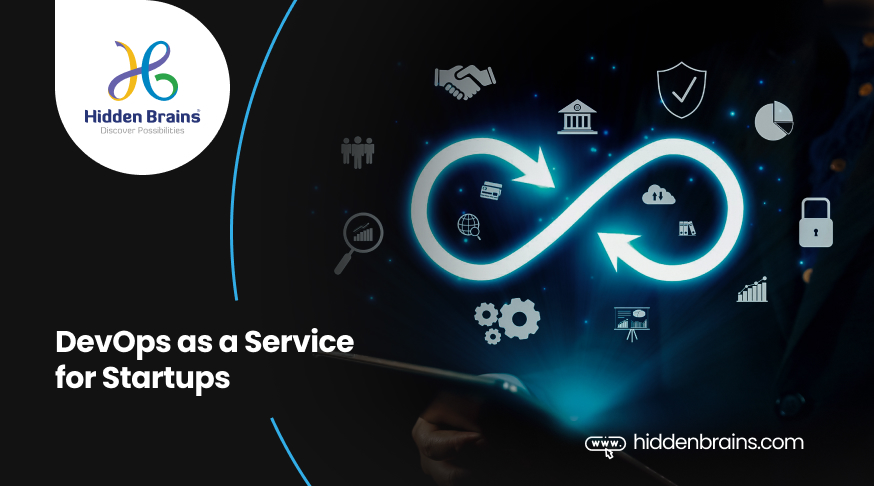Overview
The blog “Elements to Consider in the Cloud Transformation” argues that migrating to the cloud is no longer optional but imperative for modern enterprises. It outlines the conceptual differences among cloud transformation, migration, and cloud computing before detailing how cloud adoption empowers businesses via greater security, operational efficiency, collaboration, scalability, and rapid prototyping. The article then lays out a practical roadmap with strategies for aligning the cloud move with business goals, assessing operational readiness, cost planning, sourcing, creating cloud operating models, and remediating legacy systems. Hidden Brains also presents how they assist clients with their cloud transformation journey and concludes with FAQs.
The way businesses are migrating to digital platforms, “Cloud Transformation Services” no longer remain the “Next Big Thing”. Instead, cloud migration has become an urgent demand of an hour for all small, medium, and large businesses.
Cloud transformation offers several benefits such as cost savings; faster; better performance, scalability, and flexibility; or simply the ability to shift budgets from capital expenditures to operational expenditures.
It is considered an important strategy for organizations of all sizes to match the pace of modern business. Leveraging cloud services streamlines service delivery, customer engagement, and overall business management.
Consequently, cloud migration emerges as a paramount objective for companies globally. By embracing top cloud practices and technologies, businesses can gain IT agility and scalability to stay competitive in today’s dynamic market landscape.
Thus, prioritizing cloud migration aligns with the strategic imperatives of organizations aiming for sustained growth and innovation. However, many enterprises must be convinced to take the full plunge into the cloud. Whether it is a reluctance to invest the required resources or regulatory constraints, many companies fail to leverage the cloud’s deployment benefits.
Are you ready to migrate your business from local servers to a cloud ecosystem? If yes, choosing our Cloud and Infrastructure Services will ensure seamless digital transformation.
Fully embracing cloud solutions in their entirety can have a significant impact and requires substantial initial upfront investments. For this reason, before adopting cloud transformation, let’s take a broad look at the topic.
In this blog, we will examine what exactly is cloud transformation. Then we will get deep into the best practices to form a successful and efficient cloud transformation strategy that perfectly aligns with the business goals.
Let’s watch the quick video to know “Why Do Enterprises Need Cloud Transformation?”
Why Do Enterprises Need Cloud Transformation?
Understanding the Concept of Cloud Transformation
So what is cloud transformation?
The cloud transformation involves moving all aspects of business, including data, applications, and infrastructure, to the cloud. While it may seem straightforward, it can become complex without the right tech team. Hiring a reliable software development company in USA is crucial to ensure a smooth and successful cloud transformation journey.
Cloud transformation majorly refers to the migration of three aspects:
- Transitioning Applications and Software Programs to the Cloud
- Relocating Company Data to Cloud Platforms
- Shifting Your IT Infrastructure to Cloud Environments
Now the question is how long it takes to migrate your business to a cloud platform. Well, it solely depends upon the complexity of the operations. In case, you are already using cloud transformation services then you might have an idea, and may take a few months to further shift the data to clouds.
But if you haven’t yet ever opted for cloud migration solutions, then here you need to first understand why cloud transformation is important to your business and how Cloud vs On Premise choices play a role in it.
Why Do Enterprises Are Moving Towards Cloud Transformation?
Cloud migration isn’t new for businesses. But before you make a move, it is worth evaluating the market overview of cloud transformation and how rapidly top performers are leveraging cloud computing and transformation services.
- According to the MarketsandMarkets reports, the cloud computing market will reach a staggering $1,266.4 billion by 2028.
- In 2022, total spending on traditional IT servers has shrunk to 32% from 50%.
- The percentage of cloud-based application software expenditure will jump to 65.9% in 2025 from 57.7% in 2022.
- 82% of teams are using automation to optimize cloud costs.
As businesses accelerate their cloud transformation, cloud migration becomes imperative. Yet, achieving desired outcomes hinges on a well-planned and seamless cloud strategy to navigate the complexities inherent in this journey.
By hiring an mobile app developer you can easily understand and resolve the complications but moving business data to the cloud requires an in-depth understanding of how the cloud transformation actually benefits your enterprise.
How Does Business Cloud Transformation Empower Enterprises?
Firstly, the benefits of cloud transformation are not just limited to cost savings. Always remember that technology keeps changing and revolutionizing the way businesses are working. So if there is any success mantra to keep your business at the forefront, that is only to adopt a “change” to remain competitive.
So let’s take a deep look into how cloud transformation can benefit enterprises and add an edge.
1. Adding Layers of Security
Moving your business to a Cloud platform can eliminate the risk of theft and malware attacks. Keeping your data on-premises is more prone to data theft than keeping it on a cloud.
Cloud transformation services can ensure additional layers of security and encryption to restrict unauthorized access. In addition, cloud migration offers multiple data backup options which ultimately minimize the downtime and risk of system failure.
2. Improving Operational Efficiency
Having access to documents or information from anywhere, anytime with a click click is a new normal for businesses. With cloud transformation- achieving and enhancing optional efficiency can become possible.
Moving your IT infrastructure to the cloud will boost data access, assure real-time collaboration, eliminate data loss, and improve data analytical abilities across organizations. All in all, businesses can solely focus on innovations rather than conducting regular infrastructure maintenance.
Looking to lead in cloud transformation? Hire the top mobile app development company and accelerate your journey to digital innovation today!
3. Efficient Collaboration
Did you know that Cloud transformation enhances teamwork and allows them to stay connected across different time zones and foster seamless collaboration?
Cloud migration can boost productivity by allowing teams to access, retrieve, and process information anytime, giving businesses a competitive edge.
4. Streamlined Scalability
Businesses require advanced scalability to stay competitive. Cloud services, unlike on-premise systems with lengthy delays, offer a key advantage for adapting to evolving priorities in weeks, not months.
5. Rapid Prototyping
Cloud platforms empower agile development, testing, and deployment without complex infrastructure. Choosing cloud transformation services strategically considers computing resources, saving businesses from unnecessary IT investments.
Before you hire a top software development company in USA for business digital transformation, many people get confused between cloud transformation, cloud migration, and cloud computing.
So let’s get clarity over the same!

Revolutionize your business performance!
Unlock limitless possibilities with Cloud Computing.Understanding the Difference Between Cloud Transformation, Cloud Migration, and Cloud Computing
Cloud transformation, cloud migration, and cloud computing, though sounding similar, have distinct roles. Cloud transformation involves profound organizational changes to leverage cloud capabilities, while cloud migration focuses on relocating specific elements to the cloud.
In contrast, cloud computing broadly delivers on-demand computing services over the Internet. Each option brings unique strengths, contributing to the modernization and optimization of business operations in the dynamic landscape of digital technology.
However deciding to choose between cloud transformation, cloud migration, and cloud computing is challenging. Therefore, here you can refer to the quick comparison below:

What Are the Best Cloud Transformation Strategies and Practices?
To get started with the cloud transformation you will need to have the right strategy in mind. To make your cloud transformation journey a seamless experience, here we have some best cloud transformation strategies that help you achieve success.
1. Start with your Business Strategy
Remember when your enterprise makes a paradigm shift towards the cloud, it is not just a technology investment but rather a business decision. It is important to keep both your short-term and strategic business objectives in place to understand whether the cloud is the right move for your enterprise.
Understand the challenges your organization faces and define how you need to overcome challenges using the cloud. It may be infrastructure-related, process-related or even business process-related, but it’s important to know the pain areas that you need to streamline additional business functionality.
2. Analyze Operational Readiness
Second, assess your operational roadmap — the readiness of your applications for the shift to the cloud will determine your ability to take full advantage of the benefits of cloud computing. Take into consideration the design and integration complexity of each application to understand their dependencies, the amount of re-work necessary, and their overall readiness for cloud migration.
3. Cloud Computing Costs
Costs play an important role in selecting the leading cloud providers. It is important to consider pricing calculators that will help you gauge the real costs after cloud migration. Choose the best-fit Cloud solutions based on your current application workload.

4. Importance of Sourcing
While building a cloud technology stack is a challenging task. Equally challenging is the task to maintain. In such a scenario, it is important to collaborate with public cloud providers to build and manage the cloud stack. The most pragmatic way to begin is with a single cloud service provider while ensuring that you are not locked into one provider.
5. Create a Public-Cloud Operating Model
In contrast to conventional operating models, the public cloud expects IT to oversee infrastructure as code. This requires engineers with skills and understanding of computing, storage, and security protocols of a public cloud. For most businesses, this means a huge upskilling of the infrastructure organization and the working model in which they work. Specialized groups should be allocated to design, configure, and deal with the production environment.
6. Legacy-Application Remediation
Existing applications should be refactored at the framework and application layers to get in sync with the security and limit necessities of the open cloud. Security must be incorporated into these applications at the base level. This requires huge consideration from application groups, which can be difficult to get.
Best Practices for Cloud Transformation
There are many actions enterprises can take that have proven valuable to early adopters of cloud-empowered, high-performance infrastructure. These include, but are not limited to:
- Review Current IT portfolio: Before beginning any cloud development or migration, decipher and understand your existing IT portfolio to determine whether it is suited for public cloud platforms or SaaS alternatives.
- Identify the Approach: Get together all key stakeholders to determine whether your enterprise needs a transformational, aggressive, or conventional approach.
- Define IT and Business Goals: A well-defined set of outcome-oriented aspirations for both the short and long term in line with your approach.
- Securing Buy-in: Ensure commitment and investment from senior management to gain transfer from capital to operations and maintenance investments/accounting.
- Adopting New KPIs: Measure and map your technology team for standardization and automation.

Elevate your business today!
How Does Hidden Brains Can Help You With Cloud Transformation Consulting and Solutions?
Cloud transformation is offering the perfect solution to businesses that are still chasing the challenges of managing data on local servers and dealing with data thefts. This is where cloud transformation helps organizations to discover growth opportunities and ensure scalability.
If you are also finding the best ways of cloud transformation, then Hidden Brains can be a trusted tech partner for digital transformation. Here’s how Hidden Brains has simplified the cloud transformation journey for one of its prime clients and excelled in the Education sector.
So what are the challenges that our client is facing?
Understanding Client’s Problem
The client faced challenges in coordinating with over 10 stakeholders and understanding complex budgeting processes across seven business units is a troublesome task. The emergence of a new business unit required adaptability, and the client’s limited technical knowledge needed extensive support.
Staff resistance to technology and testing complexities without real data access added hurdles that have made it more complex. Addressing these challenges required a comprehensive approach for a successful digital transformation. That’s where Hidden Brains collaborated as a tech partner
Hidden Brains’ Approach To Digital Cloud Transformation
Here’s how Hidden Brains has provided a perfect solution to their clients:
- Iterative Communication Strategy: Establishing an ongoing dialogue to ensure stakeholder involvement and alignment throughout the complex undertaking.
- Dissection & Demonstration: Thoroughly understanding the complex processes through an Excel prototype, demonstrating comprehension before modifying the process for impactful changes.
- User-Centric Approach: Detailing specifications and system design in a way that is adoptable by non-technical users.
- Continuous Progressive Demonstration: A release plan involving multiple progressive demonstrations and in-depth training sessions, building confidence in the beta-stage product.
- Security Protocols & Impactful Changes: Implementation of stringent security measures and simplification of complex formulas for real impact value.
- Trial Success & Reaction: Successful trial completion within two weeks, leading to a standing ovation from the Executive Director and high praise from the Finance Director.
- Release & Continued Support: The final product replaced manual processes, generating meaningful reports for internal stakeholders and the Board of Directors. Hidden Brains continues to support the organization’s growth, ensuring a lasting and impactful digital transformation.
Here you can check for more details of the case study and understand how the Hidden Brains tech team has made the digital transformation journey possible for their clients.
FAQs
If you are still confused about what exactly is Cloud transformation and how it will help organizations to expand and collaborate, then consider our FAQ section.
What is Cloud Transformation?
Cloud Transformation is a process to relocate all the business data to cloud platforms using cloud transformation technologies. If you are looking to migrate your business data from local servers to cloud platforms, then Hidden Brains Can be your right Cloud Transformation partner.
How Long Does It Take To Migrate Your Business Data To Cloud Ecosystem?
The timeframe of cloud transformation is majorly dependent upon the complexities of the business process and its data. Moreover, the speed of migration and transformation journey experience will depend upon the type of cloud experts you choose to hire.
Why Cloud Transformation is Important for Businesses?
Cloud transformation has become crucial for organizations to stay competitive, enhancing scalability, reducing cost, and more. Moreover, it allows businesses to focus on innovation and enables them to adapt to changing market dynamics.
Does Cloud Transformation Impact Data Security?
Cloud Transformation requires robust security measures. It often includes implementing encryption, access controls, and compliance frameworks to protect data and ensure regulatory adherence.
What Does Cloud Transformation impacts on Scalability?
Scalability is a key aspect of Cloud Transformation, allowing businesses to easily adjust resources based on demand. This ensures optimal performance and cost efficiency.
Conclusion
With this blog guide, you have got a fair idea that how digital transformation can help businesses in scaling, growing and collorating with team. But the process of moving your business from local servers to cloud ecosystem is complex and required and required right skills to achieve the success.
Experts must almost certainly create applications on the cloud safely and rapidly. To do this, organizations should hire cloud specialists and afterward bring them into development groups, retrain or upskill the current workforce as required. Invest in both change management and robust development of cross-functional teams across infrastructure and security environments.
This is where Hidden Brains comes into the role holding the expertise in delivering Cloud IT Infrastructure services. Leveraging their skills and knowledge, they ensure a seamless cloud transformation journey. For more details, you can choose our cloud transformation consultation or Contact us!






























































































![Sales & Distribution [Oil & Gas] Sales & Distribution [Oil & Gas]](https://www.hiddenbrains.com/blog/wp-content/themes/blankslate/assets/images/sales_and_distribution-icon.74d08193.svg)

![Fluid Terminal Management [Oil & Gas] Fluid Terminal Management [Oil & Gas]](https://www.hiddenbrains.com/blog/wp-content/themes/blankslate/assets/images/fluid_terminal_management-icon.4b3a27a4.svg)































![Sales & Distribution [Oil & Gas] Sales & Distribution [Oil & Gas]](https://www.hiddenbrains.com/blog/wp-content/themes/blankslate/assets/images/sales_and_distribution-icon.74d08193.svg?1.0.0)
![Fluid Terminal Management [Oil & Gas] Fluid Terminal Management [Oil & Gas]](https://www.hiddenbrains.com/blog/wp-content/themes/blankslate/assets/images/fluid_terminal_management-icon.4b3a27a4.svg?1.0.0)
























































































































































































